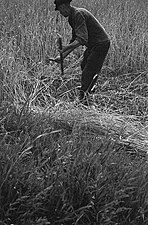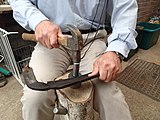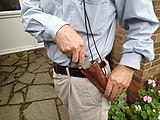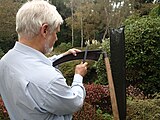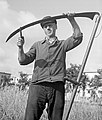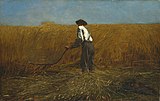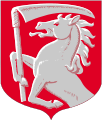Scythe


Sythe (/ saɪð/ SYDHE) bụ ngwá ọrụ aka ọrụ ugbo maka ịcha ahịhịa ma ọ bụ iwe ihe ubi. A na-eji ya eme ihe n'akụkọ ihe mere eme iji gbutuo ma ọ bụ na-aghọrọ mkpụrụ ọka oriri, tupu usoro nzọcha mkpụrụ. E jirila ígwè ndị ịnyịnya na-adọkpụ na traktọ na-adọkpụ dochie ya, ma a ka na-eji ya eme ihe n'akụkụ ụfọdụ nke Europe na Eshia. Ndị na-ewe ihe ubi bụ igwe na-akpụ akpụ nke na-eme ka ịkpụcha scythe, na mgbe ụfọdụ usoro na-esote n'ịkwadebe ọka ma ọ bụ ahịhịa ma ọ bụ ahịhịa.
Okwu "scythe" sitere na Old English siðe.[1] Na Middle English na mgbe e mesịrị, a na-asụpekarị sithe ma ọ bụ sythe. Otú ọ dị, na narị afọ nke 15, ụfọdụ ndị edemede malitere iji ntugharị ahụ dị ka ha chere (n'ụzọ na-ezighị ezi) okwu ahụ na Latin scindere (nke pụtara "ịkpụ").[2] Ka o sina dị, mkpoputa sithe ahụ dịgidere wee pụta nke ọma na akwụkwọ ọkọwa okwu Noa Webster.[1][2]

A scythe nwere oghere dị ihe dị ka 170 sentimita (67 in) n'ogologo a na-akpọ snaith, snath, snathe ma ọ bụ sned, nke a na-eji osisi eme ma Gbuo a mgbe ụfọdụ ígwè eme. Nri ndị dị mfe na-aga n'ihu na aka offset, ndị ọzọ nwere usoro "S" ma ọ bụ na-agbanye mmiri n'akụkụ atọ iji tinye aka na nhazi ergonomic ma dị nso na shaft. Nri ahụ nwere ma ọ bụ otu ma ọ bụ abụọ aka mkpirikpi n'akụkụ aka nri ya, na-abụkarị otu n'akụkụ elu ya na mgbe niile nke ọzọ n'etiti. A na-agbanwekarị aka iji kwekọọ na onye ọrụ. A na-etinye mma ígwè gbagọrọ agbagọ, nke dị n'agbata sentimita 60 na sentimita 90 (24 na 35 in) n'ogologo na njedebe ala na 90 °, ma ọ bụ obere, na snaith. Scythes fọrọ nke nta ka ọ bụrụ mgbe niile ka mma na-apụta site n'akụkụ aka ekpe nke snaith mgbe a na-eji ya eme ihe, na ọnụ ya na-aga n'ebe a na-egbutu osisi; a na-eme scythes aka ekpe mana enweghị ike iji ya na scyths aka nri dịka onye na-egwutu osisi aka ekpe ga-egbukwa n'akụkụ nke ọzọ ma ọ pụghị ịkpụ n'otu. Ọ bụ ezie na scythes ndị aka ekpe dị, ebumnuche ha bụ isi abụghị iji kwekọọ na ndị na-egbutu osisi aka ekpe kama iji wepụ azụ site na ihe mgbochi dị n'aka ekpe, dịka mgbe ị na-egwutu osisi azụ site na njedebe nke ọwara; ndị na-agbutu osisi nwere ike ịnwe ma ndị na-eji aka ekpe ma aka nri eme nke a.[3] [<span title="This citation requires a reference to the specific page or range of pages in which the material appears. (April 2024)">page<span typeof="mw:Entity"> </span>needed</span>]
Ojiji
[dezie | dezie ebe o si]
A na-akpọ iji scythe eme ihe n'akụkọ ihe mere eme, ugbu a na-esikarị ascha iji mara ọdịiche dị na ya na ịcha igwe. The mower na-ejide elu aka n'aka ekpe na Central otu n'aka nri, na ogwe aka ogologo, agụba yiri na nnọọ nso n'ala. Igwe ọkụ na-egbutu n'akụkụ ọnụ ahịhịa ahịhịa, na-edobe ahịhịa a na-egbutughị aka nri. Akara ahụ na-ejikọta ahịhịa n'aka nri ma na-efegharị ya n'aka ekpe na ogologo arc na-ejedebe n'aka ekpe nke igwe-ogwe ahụ iji mee ka ikuku nke ahịhịa a gbuturu n'ala nke a gbutere na mbụ. Igwe ọkụ ahụ na-ewe obere nzọụkwụ gaa n'ihu ma na-emegharị mmegharị ahụ, na-aga n'ihu na-ada ụda na-aga n'ihu, na-akwụsị n'oge ọ bụla iji kpoo agụba ahụ. Usoro ziri ezi na-arụ ọrụ slicing na ahịhịa, na-ahapụ swathe nke ahịhịa ọka a na-egbutu n'usoro, ma na-akpụ windo mgbe niile n'aka ekpe. [4]

Mgbe a na-egbutu ya n'otu egwuregwu, otu ahụ na-amalite na nsọtụ ala ahịhịa n'ahịrị gbagọrọ agbagọ, wee gaa n'ihu na elekere, na-agwụcha n'etiti. Iji scythe gbuchaa bụ ọrụ nwere nkà nke na-ewe oge iji mụta nke ọma. Scythes nwere ogologo ogologo, nke na-adịkarị ihe dị ka sentimita 90 (35 in) (dịka ọmụmaatụ n'okpuru) ma dabara adaba maka ịgha ahịhịa ma ọ bụ ọka wit, siri ike iji na mbụ; N'ihi ya, ndị mbido na-amalitekarị na agụba dị mkpụmkpụ, n'ozuzu 70 centimeters (28 in) ma ọ bụ obere. Njehie ndị mbido na-emekarị na-agụnye ịtọlite snith na aka na ebe na-ezighị ezi iji kwado ahụ ahụ, ịtọ agụba n'ụzọ na-ezighị ezi na ntụgharị ihu iji kwado ọnọdụ ahụ, ịhọrọ agụba nke dị ogologo maka ọkwa nkà. , na-enweghị ịmalite site na ọnụ ọnụ dị nkọ ma na-anọgidesi ike na nke na-adịghị mma n'oge a na-eji ya eme ihe, na-egbutu ma ọ bụ na-agba ọsọ na ahịhịa, na-agbalị igbutu ahịhịa sara mbara ozugbo ma jiri agụba na-akụ ala. N'akụkọ ihe mere eme, ndị mbido na-adabere na ndị ndụmọdụ iji nyere ha aka guzobe na idobe scythe ha na ịkụziri ha ka ha na-egbutu ahụ nke ọma na nke ọma.[3] [<span title="This citation requires a reference to the specific page or range of pages in which the material appears. (April 2024)">page<span typeof="mw:Entity"> </span>needed</span>]
Ịkpụ ahịhịa na-adị mfe mgbe ọ dị mmiri mmiri, ya mere ịhịa aka n'ahụ malitere n'oge chi ọbụbọ ma na-akwụsịkarị n'isi ụtụtụ, a na-eji okpomọkụ nke ụbọchị na-agbapụ ma na-ebugharị ahịhịa ndụ n'ụbọchị gara aga ma ọ bụ peening agụba.
A haziri scythes maka ọrụ dị iche iche. Ogologo ogologo, nke dị gịrịgịrị 90 ruo 100 centimeters (35 ruo 39 in) na-arụ ọrụ nke ọma maka igbutu ahịhịa ma ọ bụ ọka wit, ebe mkpirisi, siri ike siri ike 60 ruo 70 centimeters (24 ruo 28 in) kwesịrị ekwesị maka ikpochapụ ahịhịa, igbutu ahịhịa. ma ọ bụ sedge na enwere ike iji ya na agụba n'okpuru mmiri maka ikpochapụ ọwa mmiri na ụzọ mmiri. A na-eji ndị na-ahịhịa ndị nwere nkà na-eji scythes toro ogologo nke a na-akpụ akpụ nke ọma na-ejigide ahịhịa ahịhịa dị mkpụmkpụ ruo mgbe e mepụtara onye na-akwọ ahịhịa. Ọtụtụ omenala ejirila ụdị 'cradles' dị iche iche na-egbutu ụdị osisi ọka dị iche iche, na-eme ka isi mkpụrụ ahụ kwekọọ na ịtọba ha n'usoro iji mee ka ọ dị mfe ịsa ọka na ịchafụ.
Ihe a na-akpụchasị osisi
[dezie | dezie ebe o si]-
1. Mmalite nke strok mgbe ị gbasịrị n'ihu n'ime swathe. Ịkụchasị osisiRyena 1945.
-
2. Ịtụgharị aka ekpe n'ime ebe a na-ebibi ihe ma na-eme ka ọ dị omimi
-
3. Ịkwụsị ịgba bọọlụ ma tinye ya n'elu ifufe n'aka ekpe
Ịdị nkọ
[dezie | dezie ebe o si]The cutting edge of a scythe blade is maintained by occasional peening followed by frequent honing. Peening reforms the malleable edge by hammering; creating the desired edge profile, locally work-hardening the metal, and removing minor nicks and dents. For mowing fine grass, the bevel angle may be peened extremely fine, while for coarser work a larger angle is created to give a more robust edge. Peening requires some skill and is done using a peening hammer and special anvils or by using a peening jig. Historically, when mowing in teams, a peening station was set up on the edge of the field during harvest, but nowÀtụ:When more likely back in the workshop.[Tinye edensibịa][citation needed]
N'ihe atụ dị n'okpuru ebe a, a na-eme ka mma mkpụmkpụ, nke a na-eji eme ka ogwe aka dị nkọ. Tupu a kpọga ya n'oké ọhịa, a na-eme ka mma ahụ dị n'ụlọ ọrụ ahụ: nke a na-agbanwe ígwè a na-etinye n'ime ya iji mepụta profaịlụ dị n'akụkụ nke a ga-emezi. A na-eme peening naanị mgbe ụfọdụ; ugboro ole na-adabere na ike nke ígwè na ọdịdị nke ọrụ ahụ. A na-eji mma agha Austrian egosiri egosiri bepụ brambles siri ike ma na-agbanyụ ya ihe dị ka awa iri atọ ọ bụla nke ọrụ. A na-ejikarị eriri na ịkpụcha n'akụkụ mma ahụ site na ịpịpụta na profaịlụ ọhụrụ e mepụtara maka ịpịcha.[3] [<span title="This citation requires a reference to the specific page or range of pages in which the material appears. (April 2024)">page<span typeof="mw:Entity"> </span>needed</span>]
A na-eji peening jig mee ihe ebe a, mana enwere ike ịpị blades n'efu site na iji ụdị dị iche iche nke peening anvils. Ihe ngosi a na-egosi nwere okpu abụọ a na-agbanwe agbanwe nke na-etinye akụkụ dị iche iche: a na-etinye oghere siri ike na mbụ ihe dị ka 3 mm azụ site na ọnụ, a na-etinyekwa oghere dị mma n'akụkụ, na-ahapụ ọnụ nke na-eme ka ọ dị mfe. Mgbe ahụ, a na-eme ka mma ahụ dị mma site na iji nkume ndị dị mma na-eme nke ọma ma buru ya gaa n'ọhịa. N'ọhịa, a na-eme ka mma ahụ dị mma site na iji ezigbo nkume whetstone (ma ọ bụ rọba), ezigbo mkpụrụ maka ahịhịa, siri ike maka ihe ọkụkụ. A na-eme nsọpụrụ mgbe onye na-egbutu na-eche na ọnụ ya apụọla; nke a nwere ike ịbụ ọkara awa ọ bụla ma ọ bụ karịa dabere na ọnọdụ. [citation needed] Nkume a na-eme ka ọ dị mma nke egosiri ebe a nwere akara abụọ nke nkume ma na-eburu ya banye n'ọhịa na-abanye n'ime igbe jupụtara na mmiri na belt. A na-etinye burr n'èzí nke mma ahụ site na ịpị mma ahụ n'ime; mgbe ahụ, a na-ewepụ burr ahụ site na iji nwayọ na-eti ya n'èstre. E nwere ọtụtụ echiche, omenala mpaghara na ọdịiche dị iche iche banyere otu esi eme nke a; ụfọdụ mba ndị dị n'ebe ọwụwa anyanwụ Europe ọbụna guzobere burr n'ime. [5][6]
-
Akpụkpọ anụ na-egbuke egbuke. Rịba ama okpu abụọ nwere akara.
-
Iji jig na-akpụ akpụ mma
-
Nkume a na-ahụkarị nke a na-etinye n'ime mmiri jupụtara na ya
-
Ịtọlite ịnyịnya ibu n'èzí nke mma ahụ site n'ịtụgharị n'ime
-
Ihichapụ burr n'èzí nke mma ahụ site n'ịtụgharị n'èstre
-
Mma agha a rụchara arụcha
-
Foto sitere na owuwe ihe ubi rye nke afọ 1945, na-egosi ogologo mma a na-eme ka ọ dị mma n'ọrụ ahụ. Ịtọlite ịnyịnya ibu.
-
Wepụ ịnyịnya ibu dị n'èzí, dị njikere ịkpụcha ọzọ
N'adịghị ka mma ndị Europe, nke a na-eji ígwè na-eme ka ọ dị nro, a na-eme mma ndị America siri ike, nke na-emebi emebi, na ihe ize ndụ nke ịgbaji ma ọ bụrụ na e wepụ ya. Ọ bụ ezie na mma siri ike na-ejide ọnụ ogologo oge ma chọọ obere ịkpụcha n'ọhịa, enwere ike ịmegharị ọnụ ahụ naanị site na ịcha ya mgbe ejiri ya mee ihe ma ọ bụ mebie ya. Nke a na-achọkarị ime naanị ugboro 1-3 n'oge n'ihi ike ọgwụgwụ nke ígwè siri ike. Ihe atụ ụfọdụ nwere ihe owuwu laminated nke nwere isi siri ike, nke na-eguzogide mmebi na-enye ọnụ, na akụkụ dị nro na-enye ike. Na blades ndị America, a na-ejikarị ígwè siri ike kpuchie akụkụ ya n'akụkụ ọ bụla, ebe ụfọdụ blades ndị Nordic nwere akwa ígwè n'elu naanị, na ọnụ ígwè mejupụtara akwa ala. [7][8]
Akụkọ ihe mere eme
[dezie | dezie ebe o si]
Scythes may date back as far as Àtụ:Circa; they seem to have been used since Cucuteni–Trypillia settlements, becoming widespread with agricultural developments.[Tinye edensibịa][citation needed] Initially used mostly for mowing hay, it had replaced the sickle for reaping crops by the 16th century, as the scythe was better ergonomically and consequently more efficient.[Tinye edensibịa][citation needed] In about 1800, the grain cradle was sometimes added to the standard scythe when mowing grain; the cradle was an addition of light wooden fingers above the scythe blade which kept the grain stems aligned and the heads together to make the collection and threshing easier. In the developed world, the scythe has been largely replaced by the motorised lawn mower and combine harvester. However, the scythe remained in common use for many years after the introduction of machines because a side-mounted finger-bar mowerÀtụ:Sndwhether horse- or tractor-drawnÀtụ:Sndcould not mow in front of itself, and scythes were still needed to open up a meadow by clearing the first swathe to give the mechanical mower room to start.[Tinye edensibịa]


The Dictionary of Greek and Roman Antiquities of Sir William Smith argues that the scythe, known in Latin as the falx foenaria as opposed to the sickle, the falx messoria, was used by the ancient Romans.[Tinye edensibịa][citation needed] According to ancient Greek mythology, GaiaÀtụ:Sndthe Greek goddess and mother of the TitansÀtụ:Sndgave a sickle made of the strongest metal to her youngest son Kronos, who is also the youngest of the Titans and god of the harvest, to seek vengeance against her husband Ouranos for torturing their eldest sons. The Grim Reaper is often depicted carrying or wielding a scythe. According to Jack Herer and Flesh of The Gods (Emboden, W. A. Jr., Praeger Press, New York, 1974), the ancient Scythians grew hemp and harvested it with a hand reaper that would be considered a scythe.[Tinye edensibịa]
Abbeydale Industrial Hamlet dị na Sheffield, England, bụ ebe ngosi nka nke ọrụ na-eme mma agha nke na-arụ ọrụ site na ngwụcha narị afọ nke 18 ruo n'afọ ndị 1930. Nke a bụ akụkụ nke mpaghara na-eme mma owuwe ihe ubi nke ugwu Derbyshire, nke gbatịrị n'ime Eckington.[9] Mpaghara ndị ọzọ na-eme mma agha n'England gụnyere nke dị gburugburu Belbroughton.[10]
mma agha nke German Renaissance, ụbọ akwara ndị Gris na ndị Rom na khopesh ndị Ijipt bụ mma agha ma ọ bụ mma agha gbanwere dị ka ngwá agha ma ọ dị ka akara nke ikike. A na-ejikwa ntụgharị nke mma agha na-arụ ọrụ n'oge na-adịghị anya site na itinye mma agha ahụ n'akụkụ snaith, nke yiri ụgwọ, mee ihe n'akụkọ ihe mere eme niile dị ka ngwá agha. Lee § Na nka dị n'okpuru maka ihe atụ.
N'omenala mba
[dezie | dezie ebe o si]Ọ bụ ezie na mma agha ka bụ ngwá ọrụ dị mkpa maka ndị ọrụ ugbo na mba ndị na-emepe emepe na ugwu ugwu, ngwá ọrụ ahụ ejikọtala ya na Grim Reaper.Onye na-ere nri.
Na Romania, dịka ọmụmaatụ, n'ọhịa dị elu nke ugwu Transylvania Apuseni, scything bụ ọrụ dị mkpa kwa afọ, na-ewe ihe dị ka izu 2-3 iji mezue maka ụlọ nkịtị.[11] Dị ka scything bụ mmega ahụ na-agwụ ike ma sie ike ịmụta, ndị ọrụ ugbo na-enyere ibe ha aka site n'ịmepụta otu. Mgbe owuwe ihe ubi nke ụbọchị ọ bụla gasịrị, ndị ọrụ ugbo na-emekarị ememe site n'inwe obere oriri ebe ha na-agba egwú, na-aṅụ ma na-eri nri, ka ha na-akpachara anya ka ha nọgide na-arụ ọrụ ike n'ụbọchị na-esote. N'akụkụ ndị ọzọ nke Balkan, dịka n'obodo ndị Serbian, a na-eme asọmpi scything ebe onye mmeri na-ewepụ obere mma ọlaọcha.[12] N'ime obere obodo ndị Serbia, a na-eji scything akpọrọ ihe dị ka akụkụ nke akụkọ ọdịnala obodo, a na'enyekwa ndị mmeri nke asọmpi enyi na enyi ụgwọ ọrụ bara ụba site na nri na ihe ọṅụṅụ, nke ha na ndị asọmpi ha na-ekerịta.[13]
N'etiti asọmpi ịkpụ ụta nke Ndị Basque ka bụ egwuregwu ọdịnala a ma ama, nke a na-akpọ segalaritza (site na ngwaa Spanish segar: ịkpụ ụrọ). Onye ọ bụla na-asọ mpi na-asọmpi igbu akụkụ ahịhịa a kapịrị ọnụ tupu onye iro ya emee otu ihe ahụ.
E nwere asọmpi mba ụwa nke e mere na Goričko ebe ndị si Austria, Hungary, Serbia, na Romania, ma ọ bụ n'ebe dị anya dị ka Eshia na-abanye iji gosipụta usoro ha pụrụ iche nke owuwe ihe ubi. [14][15] N'afọ 2009, otu nwoke Japan gosipụtara ngwá ọrụ owuwe ihe ubi osisi nwere ọnụ ígwè, nke o ji gosipụta otú e si egbutu osikapa. Ọ masịrị ya na ọsọ nke ndị na-ewe ihe ubi n'ógbè ahụ, mana o kwuru na nnukwu mma agha dị otú ahụ agaghị arụ ọrụ na Japan. [citation needed]
Obodo Norwegian nke Hornindal nwere mma mma atọ na uwe agha ya.
Na Poland, ọkachasị mpaghara ndị gbara Kraków gburugburu, ncheta nke Scythemen (Polish: Kosynierzy) nke 1794 Kościuszko Uprising ka dị ndụ ma na-echeta. Iji mee ka ndị agha Poland sie ike megide ndị Russia, Kościuszko wepụtara iwu nke ịhazi, mana ihe isi ike nke inye ngwá agha zuru ezu maka ndị agha a kwadoro mere ka Kościusko mepụta nnukwu ndị ọrụ ugbo ji scythes. Ụkpụrụ nduzi ha bụ Ha Na-enye Nri ma Na-echebe (Polish: Żywią na BroniąŻywią na Bronią: Żyvest y Bronią).
Ihe nnọchianya nke Bnei Akiva, Òtù ndị ntorobịa okpukpe Ndị Juu, nwere ọka wit, mma na pitchfork, na-anọchite anya ọrụ ugbo na njikọta nke ọrụ ala na Torah.
N'afọ 2012, The Wall Street Journal kọrọ na ụfọdụ ndị nwe ụlọ America na-ezere ndị na-egbutu ahịhịa na-eji ụgbọala eme ihe maka mma, na-ekwu maka enweghị mkpọtụ yana uru ahụike nke owuwe ihe ubi dị ka mmega ahụ.[16]
N'ihe osise
[dezie | dezie ebe o si]-
1817 Ihe osise nke onye ọrụ ugbo Poland na-eme ka mma dị nkọ (nke e sere site naJan Piotr Norblin, nke e serePhilibert-Louis Debucourt)
-
Ọnwụ na onye na-egbu osisisite naJean-François Millet, 1859
-
Niittomiehet (Ndị ikom na-egwe osisi), site naPekka Halonen, 1891
-
Nwa okorobịa Sweden na mmaMfu nke Södermark, akụkụ nke abụọ nke narị afọ nke 19
-
Winslow Homer,Onye Agha n'Ọhịa Ọhụrụ, 1865
-
Aịnyịnyana-ejide mma agha n'ime uwe agha nkeOrimattila
Hụkwa
[dezie | dezie ebe o si]- Billhook, ụdị mma owuwe ihe ubi a na-eji egbutu osisi na alaka
- Ọnwụ, ọdịbendị nke e gosipụtara n'akụkọ ifo ụfọdụ dị ka onye na-eji mma agha
- Ebe a na-etinye mkpụrụ, maka ịhazi ogwe ọka
- Harpe, ogologo mma owuwe ihe ubi nke ndị Gris ma ọ bụ ndị Rom nke a na-eji eme ihe ugboro abụọ
- Kama (ngwá ọrụ), mma agha aka nke ndị Japan na-eji n'ọrụ ugbo, na nkà ọgụ
- Khopesh, mma owuwe ihe ubi ma ọ bụ mma owuwe okwu nke Ijipt dị ka ngwá agha
- Mma agha Scythe, mma agha a gbanwere iji mee ihe dị ka ngwá agha
- Sickle, onye bu ụzọ na-eme ihe n'oge gara aga
- String trimmer, ngwá ọrụ ubi maka ịkpụ ahịhịa na mkpuchi ala nke na-eji eriri monofilament na-agbanwe agbanwe kama mma agha
- Agha mma agha, ogwe aka yiri mma agha gbanwere
Ebem si dee
[dezie | dezie ebe o si]- ↑ Browse 1828 => Word SITHE :: Search the 1828 Noah Webster's Dictionary of the English Language. 1828.mshaffer.com (2012-06-03). Retrieved on 2012-06-03.
- ↑ Browse 1913 => Word SITHE :: Search the 1913 Noah Webster's Dictionary of the English Language. 1913.mshaffer.com (2012-06-03). Archived from the original on 2012-12-03. Retrieved on 2012-06-03.
- ↑ 3.0 3.1 3.2 (2016) The Scything Handbook (in en-GB). Filbert Press. ISBN 9780993389245. Retrieved on 2023-07-26. Kpọpụta njehie: Invalid
<ref>tag; name "Scything handbook" defined multiple times with different content - ↑ How to Use a Scythe – Modern Homesteading – Mother Earth News (May 1981).
- ↑ Peening and Sharpening – Scythe Cymru.
- ↑ Tomlin (31 May 2016). Learning to peen a scythe.
- ↑ Peening and Sharpening – Scythe Cymru.
- ↑ Tomlin (31 May 2016). Learning to peen a scythe.
- ↑ K. M. Battye, "Sickle-makers and other metalworkers in Eckington 1534–1750: a study of metal workers tools, raw materials and made goods, using probate wills and inventories". Tools and Trades 12 (2000), 26–38.
- ↑ P. W. King, "The north Worcestershire Scythe Industry" Historical Metallurgy 41(2), 124–147.
- ↑ Reif (2008). "A Traditional Cultural Landscape in Transformation". Mountain Research and Development 28: 18–22. DOI:10.1659/mrd.0806.
- ↑ Hay making on Rajac. Visitserbia.org. Retrieved on 2011-03-09.
- ↑ Serbian Scything Competition on Mt. Plavinac photo | stock photos Profimedia #0071934552. Profimedia.rs (2010-06-13). Retrieved on 2011-03-09.
- ↑ Krajinski park Goričko. Park-goricko.org (2010-05-21). Retrieved on 2011-03-09.
- ↑ Blog Archives. The One Scythe Revolution (2010-02-28). Retrieved on 2011-03-09.
- ↑ Newman. "Who Needs a WeedWacker When You Can Use a Scythe? Grim Reaper Jokes Aside, Suburbanites Take Swing at Ancient Mower", Wall Street Journal, June 29, 2012. Retrieved on 1 July 2012.


